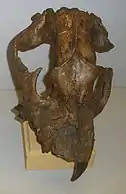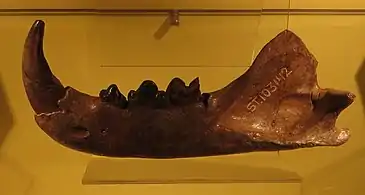Panthera gombaszoegensis
Panthera gombaszoegensis, also known as the European jaguar, is a Panthera species that lived from about 2.0 to 0.35 million years ago in Europe.[1] The first fossils were excavated in 1938 in Gombasek, Slovakia.[2]
| Panthera gombaszoegensis Temporal range: | |
|---|---|
_Panthera_onca_gombaszoegensis.png.webp) | |
| Scientific classification | |
| Domain: | Eukaryota |
| Kingdom: | Animalia |
| Phylum: | Chordata |
| Class: | Mammalia |
| Order: | Carnivora |
| Suborder: | Feliformia |
| Family: | Felidae |
| Subfamily: | Pantherinae |
| Genus: | Panthera |
| Species: | †P. gombaszoegensis |
| Binomial name | |
| †Panthera gombaszoegensis (Kretzoi, 1938) | |
| Synonyms | |
| |
More of its fossil remains were excavated from the Olivola site in Italy, while finds elsewhere in Italy were initially named Panthera toscana.[3] Later fossils were found in England, Germany, Spain, France, and the Netherlands. Sometimes it is recognized as a subspecies of Panthera onca, the jaguar, as Panthera onca gombaszoegensis.[4]
Description
European jaguars were larger than modern-day jaguars found in South America.[5][6] With a body weight between 70–210 kilograms (150–460 lb),[7] they were therefore probably capable of bringing down larger prey. Like other Panthera species, they are thought to have been sexually dimorphic, with significantly larger males.[1]
History
The ancestors of jaguars are thought to have arisen in Africa; a related form of Panthera was present in South Africa 1.9 Ma ago.[7] Another form similar to P. gombaszoegensis has been found dating from early Pleistocene East Africa and had both lion- and tiger-like characteristics.[5] P. gombaszoegensis was initially the only European Pantherinae species in the Early Pleistocene, being present alongside the felines Acinonyx pardinensis[8] and Puma pardoides and the machairodontines Homotherium latidens and Megantereon whitei.[9] Leopards arrived later in the Early Pleistocene[9] or the Middle Pleistocene,[1] and lions in the Middle Pleistocene.[1]
Taxonomy
Leo gombaszoegensis was the scientific name proposed by Miklós Kretzoi in 1938 for teeth found in Tertiary deposits in Gombasek Cave, Slovakia.[2] It was reassessed and subordinated to the genus Panthera in 1971. The following are considered to belong to P. gombaszoegensis as well:[10][11][12]
- Panthera toscana proposed in 1949 for carnassial teeth found in Villafranchian deposits in the Arno river valley in Italy.[13] These remains were originally described as a distinct species and later as subspecies Panthera gombaszoegensis toscana.[3][7] It is sometimes referred to as the Tuscany jaguar or Tuscany lion.
- Felis (Panthera) schreuderi proposed in 1960 for cat fossils found in Tegelen, the Netherlands.[14]
- Jansofelis vaufreyi proposed in 1971 for cat fossils found in southeastern France.[15]
Some remains once attributed to P. gombaszoegensis have more recently been identified as Acinonyx pardinensis.[8]
A 2022 study based on a relatively complete skull from Belgium suggested that P. gombaszoegensis is more closely related to the tiger (Panthera tigris), than the jaguar.[16]
Habitat and behavior
The European jaguar has often been thought to be a forest-dwelling cat, similar in habits to the modern jaguar, although recent work suggests that the association between the European jaguar and forested habitats is not as strong as has often been assumed.[17] It was probably a solitary animal.
See also
References
- Marciszak, A. (2014). "Presence of Panthera gombaszoegensis (Kretzoi, 1938) in the late Middle Pleistocene of Biśnik Cave, Poland, with an overview of Eurasian jaguar size variability". Quaternary International. 326–327: 105–113. Bibcode:2014QuInt.326..105M. doi:10.1016/j.quaint.2013.12.029.
- Kretzoi, Miklós (1938). "Die Raubtiere von Gombaszög nebst einer Ubersicht der Gesamtfauna" [The predators of Gombaszög together with an overview of the overall fauna] (PDF). Annales historico-naturales Musei nationalis hungarici (in German). Budapest: Hungarian Natural History Museum. 31: 88–157. ISSN 0521-4726.
- Turner, A.; Anton, M. (1997). The Big Cats and Their Fossil Relatives: An Illustrated Guide to Their Evolution and Natural History. Columbia University Press. ISBN 9780231102285.
- Hemmer, H.; Kahlke, R.-D. (2005). "Nachweis des Jaguars (Panthera onca gombaszoegensis) aus dem späten Unter- oder frühen Mittelpleistozän der Niederlande". Deinsea, Annual of the Natural History Museum Rotterdam: 47–57.
- Mol, D.; van Logchem, W.; de Vos, J. (2011). "New record of the European jaguar, Panthera onca gombaszoegensis (Kretzoi, 1938), from the Plio-Pleistocene of Langenboom (The Netherlands)". Cainozoic Research. 8 (1–2): 35–40. Retrieved 2015-09-28.
- Seymour, K.L. (1989). "Panthera onca" (PDF). Mammalian Species (340): 1–9. doi:10.2307/3504096. JSTOR 3504096. S2CID 253932256. Retrieved 2015-09-04.
- Argant, Alain; Argant, Jacqueline (2011). "The Panthera gombaszogensis story: the contribution of the Château Breccia (Saône-et-Loire, Burgundy, France)". Quaternaire (Hors-serie 4): 247–269.
- Cherin, M.; Iurino, D.A.; Zanatta, M.; Fernandez, V.; Paciaroni, A.; Petrillo, C.; Rettori, R.; Sardella, R. (2018). "Synchrotron radiation reveals the identity of the large felid from Monte Argentario (Early Pleistocene, Italy)". Scientific Reports. 8 (1): 8338. Bibcode:2018NatSR...8.8338C. doi:10.1038/s41598-018-26698-6. PMC 5974229. PMID 29844540.
- Rodríguez, J.; Mateos, A. (2018). "Carrying capacity, carnivoran richness and hominin survival in Europe". Journal of Human Evolution. 118: 72–88. doi:10.1016/j.jhevol.2018.01.004. PMID 29606204.
- Hemmer, H. (1971). "Zur Charakterisierung und stratigraphischen Bedeutung von Panthera gombaszoegensis (Kretzoi, 1938)". Neues Jahrbuch für Geologie und Paläontologie, Monatshefte. 12: 701–711.
- Hemmer, H. (1972). "Zur systematischen Stellung von "Jansofelis vaufreyi" BONIFAY, 1971, und "Felis lunellensis" BONIFAY, 1971, aus dem Pleistozän Südfrankreichs (Carnivora, Felidae)". Neues Jahrbuch für Geologie und Paläontologie, Monatshefte: 215–223.
- O'Regan, H.; Turner, A. (2004). "Biostratigraphic & palaeoecological implications of new fossil felid material from the Plio-Pleistocene site of Tegelen, the Netherlands". Palaeontology. 47 (5): 1181–1193. Bibcode:2004Palgy..47.1181O. doi:10.1111/j.0031-0239.2004.00400.x. S2CID 85114506.
- Schaub, S. (1949). "Révision de quelques Carnassiers villafranchiens du niveau des Etouaires (Montagne de Perrier, Puy-de-dôme)". Eclogae Geologicae Helvetiae. 42 (2): 492–506.
- von Koenigswald, G. H. R. (1960). "Fossil cats from the Tegelen clay". Publicaties van het Natuurhistorisch Genootschap in Limburg. 12: 19–27.
- Bonifay, M. F. (1971). Carnivores Quarternaires du Sud-Est de la France. Nouvelle série C. Vol. 31. Paris: Mémoires du Muséum National d´Histoire Naturelle. p. 377.
- Chatar, Narimane; Michaud, Margot; Fischer, Valentin (September 2022). Silcox, Mary (ed.). "Not a jaguar after all? Phylogenetic affinities and morphology of the Pleistocene felid Panthera gombaszoegensis". Papers in Palaeontology. 8 (5). doi:10.1002/spp2.1464. ISSN 2056-2799. S2CID 252489047.
- O'Regan, H.J.; Turner, A. (2002). "Wilkinson. European Quaternary refugia: a factor in large carnivore extinction?" (PDF). Journal of Quaternary Science. 17 (8): 789–795. doi:10.1002/jqs.693. S2CID 130275622. Archived from the original (PDF) on 2006-08-21. Retrieved 2006-07-02.


